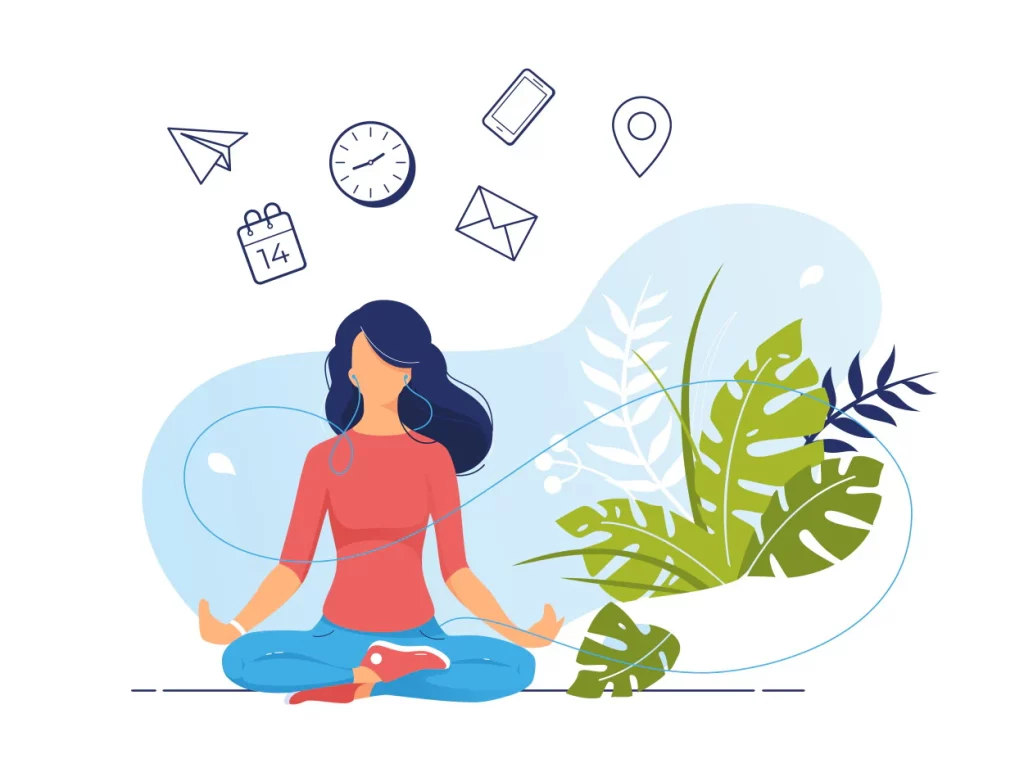Mindfulness Practices to Reduce Stress
Jessica White August 19, 2025
In 2025, mindfulness has moved far beyond a simple wellness trend—it has become an essential part of modern life. With increasing stress from work, social pressures, and technology overuse, people are searching for effective ways to manage mental load and improve overall well-being. Mindfulness practices to reduce stress are now backed by research, integrated into workplaces, and enhanced by technology, offering accessible, practical methods to calm the mind. This article explores the most effective and trending approaches to mindfulness in 2025.

1. AI-Guided Meditation: Personalized Mindfulness at Your Fingertips
Artificial Intelligence (AI) is transforming mindfulness. AI-guided meditation programs adapt sessions to individual needs, tracking progress and suggesting personalized exercises to optimize mental relaxation.
How AI Enhances Mindfulness Practice
- Personalized Sessions: AI analyzes user behavior, stress levels, and preferences to provide tailored meditation programs.
- Adaptive Feedback: Some apps adjust background sounds, session length, and techniques based on real-time feedback.
- Accessibility: Individuals with little prior meditation experience can begin guided practices without feeling overwhelmed.
Practical Steps to Use AI Meditation
- Download a Reputable AI Meditation App: Examples include Calm, Headspace, or AI-powered newer apps in 2025.
- Set Your Stress Goals: Determine whether you want to reduce work stress, sleep better, or enhance focus.
- Follow Personalized Guidance: AI will recommend meditation length, type (breathing, visualization, body scan), and frequency.
- Track Progress: Regularly review feedback to notice stress reduction trends and areas for improvement.
Long-Term Benefits: Personalized AI meditation can reduce cortisol levels, improve focus, and foster emotional regulation over time.
2. Mindful Micro-Meditations: Quick Relief in Busy Lives
Even a few minutes of mindfulness can produce measurable stress relief. Mindful micro-meditations, lasting 2–5 minutes, are ideal for busy schedules.
How to Incorporate Micro-Meditations
- Morning Reset: Spend 3–5 minutes breathing deeply before starting your day.
- Work Breaks: Pause for a micro-meditation after meetings or intense tasks.
- Before Sleep: Use a short meditation session to clear your mind and improve sleep quality.
Practical Example: Try the 4-7-8 breathing method: inhale for 4 counts, hold for 7, exhale for 8, repeating for 3–5 cycles.
Benefits: Short, consistent mindfulness sessions improve attention, reduce stress reactivity, and encourage long-term habit formation.
3. The Slow Living Movement: Reducing Stress by Slowing Down
Slow living emphasizes intentional, mindful living and counters the fast-paced, productivity-driven lifestyle common today.
Principles of Slow Living
- Mindful Consumption: Choose products and experiences thoughtfully to reduce mental clutter.
- Quality Relationships: Focus on meaningful interactions rather than superficial connections.
- Sustainable Practices: Eco-conscious habits enhance both personal and planetary well-being.
Daily Tips for Slow Living
- Schedule technology-free periods daily.
- Practice “single-tasking” instead of multitasking.
- Engage in mindful hobbies such as cooking, gardening, or journaling.
Impact on Stress: Slow living reduces cognitive overload and fosters a sense of purpose, decreasing anxiety and increasing life satisfaction.
4. Workplace Mindfulness Programs: Supporting Mental Health
Companies are increasingly adopting mindfulness programs to enhance employee well-being, productivity, and resilience.
Popular Workplace Initiatives
- Mindfulness-Based Stress Reduction (MBSR): Structured programs that teach meditation, breathing exercises, and yoga.
- Quiet Spaces: Offices provide dedicated areas for employees to practice mindfulness.
- Regular Workshops: Ongoing education about stress management and mindfulness strategies.
Implementation Tips: Encourage daily short mindfulness exercises, incorporate mindfulness breaks in team meetings, and provide access to apps or in-person sessions.
Research Insight: Studies show that workplace mindfulness programs reduce burnout, increase job satisfaction, and improve emotional resilience.
5. VR Meditation and Immersive Mindfulness Experiences
Virtual Reality (VR) is a rising trend in mindfulness for 2025. VR environments simulate calming natural scenes and guide users through meditative experiences.
Benefits of VR Mindfulness
- Immersive Relaxation: VR provides distraction-free environments, ideal for reducing stress.
- Accessible Escapes: Users can experience nature, beaches, or forests without leaving their home or office.
- Engagement: Gamified VR meditation enhances motivation and consistency.
Example Exercise: Use a VR program to visualize walking through a forest while synchronizing your breathing with gentle audio cues.
6. Sound Therapy and Mindful Listening
Sound therapy, including binaural beats, chanting, and nature sounds, is increasingly incorporated into mindfulness practices.
How to Practice Mindful Listening
- Morning Ritual: Listen to calming sounds for 10 minutes after waking.
- Work Break: Use sound therapy to reset focus and reduce accumulated stress.
- Evening Wind Down: Incorporate calming music or nature sounds before bedtime.
Scientific Support: Research indicates that sound therapy can lower heart rate, reduce stress hormones, and enhance overall relaxation.
7. Digital Detoxing: Mindfulness Through Disconnection
In 2025, reducing digital overload is a critical component of stress management.
Steps to a Mindful Digital Detox
- Set Boundaries: Limit screen time to essential activities.
- Create Tech-Free Zones: Avoid devices during meals or before sleep.
- Schedule Offline Time: Dedicate blocks of time for mindful reflection, walking, or hobbies.
Benefits: Lowered cortisol levels, improved sleep, and increased focus.
8. Mindful Movement: Yoga, Tai Chi, and Walking Meditation
Physical activity combined with mindfulness enhances stress reduction by connecting body and mind.
Types of Mindful Movement
- Yoga: Combines breath control, meditation, and physical postures.
- Tai Chi: Slow, deliberate movements with focus on breath and posture.
- Walking Meditation: Walking slowly while maintaining full awareness of each step.
Tip: Start with 10–15 minutes daily and gradually increase duration. Mindful movement not only reduces stress but also improves posture, circulation, and flexibility.
9. Mindful Journaling and Reflection
Writing about thoughts and emotions is a powerful stress-reduction tool.
How to Practice Mindful Journaling
- Daily Reflection: Spend 5–10 minutes noting feelings, triggers, and moments of gratitude.
- Focus on Sensations: Describe your emotional and physical state to increase awareness.
- Set Intentions: Write mindful goals for the day to cultivate awareness and focus.
Benefit: Journaling increases emotional clarity, reduces rumination, and promotes self-awareness.
10. Combining Practices for Maximum Effect
Integrating multiple mindfulness strategies enhances stress reduction.
Sample Daily Routine
- Morning: 5-minute micro-meditation + journaling.
- Midday: VR meditation or sound therapy during lunch break.
- Evening: Yoga or Tai Chi + mindful reflection before bed.
Tip: Adjust activities to your schedule, lifestyle, and stress levels. Consistency is more important than duration.
The Science Behind Mindfulness and Stress Reduction
Numerous studies confirm the physiological and psychological benefits of mindfulness:
- Cortisol Reduction: Regular mindfulness meditation lowers cortisol, the primary stress hormone.
- Improved Cognitive Function: Mindfulness improves focus, attention, and working memory.
- Emotional Regulation: Practitioners experience fewer negative emotional reactions and increased resilience.
Sources:
- Mindful Leader (2025) – Trends Shaping Mindfulness
- Siddha Meditate (2025) – Health and Wellness Trends
- My Journal Courier (2025) – Why Slow Living Is the Next Big Lifestyle Trend
Conclusion
As life becomes increasingly complex, mindfulness practices provide essential tools to reduce stress and enhance well-being. Emerging trends in 2025—including AI-guided meditation, mindful micro-meditations, VR mindfulness, sound therapy, slow living, and digital detoxing—offer practical and scientifically supported methods to improve mental health. By integrating these practices into daily routines and workplaces, individuals can achieve long-term stress reduction, improved focus, and emotional balance. Mindfulness is no longer optional—it is a necessary approach to navigating modern life with clarity, calm, and intentionality.
References
- Guided. (n.d.). Home. Available at: https://www.guidedapp.ai (Accessed: 19 August 2025).
- Texas A&M University. (2025, January 28). Virtual reality meditation can alleviate depression and anxiety symptoms. Available at: https://stories.tamu.edu (Accessed: 19 August 2025).
- Spa Executive. (2024, November 14). 2025 wellness trends: Speed x 0.5: Slow living. Available at: https://spaexecutive.com (Accessed: 19 August 2025).







